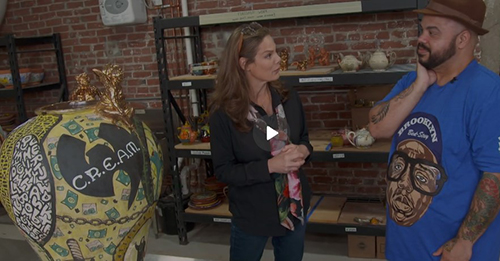See our friend and CerPrint user, Roberto Lugo, on “PBS News Hour CANVAS” and on “CBS Sunday Morning.” We’ve collected select quotes from the interviews plus links to the full features. Another link opens a window to Lugo’s upcoming show at The Met. Roberto Lugo incorporates ceramic decals from the CerPrint ceramic decal printer in his work.
“PBS News Hour CANVAS”
How artist Roberto Lugo is upending porcelain traditions with his personal, cultural roots
https://www.pbs.org/newshour/show/how-artist-roberto-lugo-is-upending-porcelain-traditions-with-his-personal-cultural-roots
Roberto explains his exhibit at the Currier Museum of Art in New Hampshire, “features images of protests, of historical figures like Angela Davis and Black thought and people that have really inspired me to make me who I am. I couldn’t be that without those people.” His family features prominently in the displayed works.
“CBS Sunday Morning”
Philadelphia Pottery Artist Roberto Lugo
https://www.cbsnews.com/video/philadelphia-pottery-artist-roberto-lugo/
Roberto creates a modern spin on classic teapots and ceramics. He was introduced to ceramics at a community college in his mid-20s. Roberto eventually earned a master’s degree from the Penn State School of Visual Arts.
Some of Roberto’s works sell for tens of thousands of dollars. “Yea this is going to a fellow potter, Seth Rogan,” Roberto explained to CBS Correspondent, Serena Altschul. “For me, being ghetto is where my life begins, and it’s where I get my creativity and my resourcefulness. So I really want to represent that wherever I go.”
The Met Fifth Avenue beginning Nov. 5, 2021.
“Before Yesterday We Could Fly: An Afrofuturist Period Room”
https://www.metmuseum.org/exhibitions/listings/2021/afrofuturist-period-room
The room story begins with the real history of a vibrant community founded by free black tenants and landowners. Seneca Village flourished from 1820 to 1850 near The Met’s modern site. According to The Met, the City of New York destroyed Seneca Village in 1857. It used eminent domain to seize land and construct Central Park. That decision made way for a different type of place intended for a wholly different community.”
See more: robertolugostudio.com, Instagram @robertolugowithoutwax

